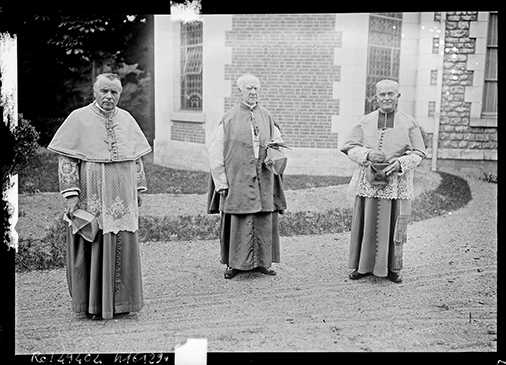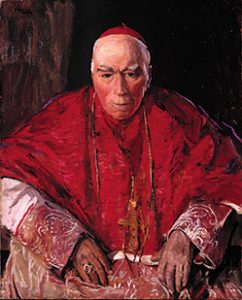French bishops’ mission to Ireland, October 1916
Published in Features, Issue 5 (September/October 2016), Revolutionary Period 1912-23, Volume 24SECULAR FRANCE AND CATHOLIC FRANCE SET ASIDE THEIR DIFFERENCES AND ABLY USED RELIGION TO BENEFIT THEIR CAUSE DURING THE WAR
By Oliver O’Hanlon
One hundred years ago, in the middle of the First World War, a small group of French clergymen visited Ireland. News of their visit was reported in the Irish, British and French press but did not generate much excitement. In the Irish press it was described as a mission to create a closer bond between the French Catholic Church and its Irish counterpart. Its real purpose, however, was to gauge the mood in Ireland as regards the war, to counteract German propaganda that had made its way to Ireland and to encourage Irishmen to enlist in the British army. French clergymen also undertook similar missions to Spain, Canada, the United States and South America.
Concerns
The visit to Ireland came about following concerns about Ireland’s current and future role in the war raised by a combination of Irish politicians and a group of French senior civil servants and diplomats. These included the Irish Parliamentary Party MP T.P. O’Connor and officials in the French Ministry of Foreign Affairs in Paris, the French embassy in London and the French consul in Dublin. O’Connor was a member of the delegation of senior Irish politicians, which included the lord mayor of Dublin, that travelled to Paris in April 1915 to show solidarity with the French people. During that visit they met with the French prime minister, the president and the archbishop of Paris, Cardinal Amette. In October 1916 the French government sent a deputation to Ireland. To avoid antagonising the Irish with a French political deputation that might be seen as authoritarian, however, it was decided that the French Catholic Church was the most suitable go-between.
Between 7 and 14 October 1916, the group of French clergymen—the bishop of Orléans, Msgr Stanislas Touchet; the bishop of Digne, Msgr Léon-Adolphe Lenfant; the canon of Nôtre Dame Cathedral, Fr Pierre Batiffol; and Fr Patrice Flynn—spent time in Dublin, Maynooth and Armagh. They gave several speeches and met with members of the Irish hierarchy and clergy, and with officials in Dublin. Their trip had been planned in close co-operation with the French government. On their way to Ireland they paid a visit to the French ambassador in London, Paul Cambon, and were accompanied to Ireland by André Géraud of the embassy in London. Géraud had travelled to Ireland in June 1916, when he was sent to sound out the Irish hierarchy on their attitude to the war and make preparations for this present mission.

Above: One of the leaders of the French Catholic Church delegation to Ireland in October 1916, the bishop of Orléans, Msgr Stanislas Touchet (left), with the auxiliary bishop of Dublin, Nicholas Donnelly (centre), and the bishop of Digne, Léon-Adophe Lenfant (right), at the annual Mass in Orléans for Joan of Arc (canonised in 1920) in May 1917. (Agence Rol)
Surrounded in mystery
The October trip was timed to coincide with the annual meeting of the Irish Catholic bishops’ conference, which was taking place in Maynooth. For many, the exact purpose of this visit was shrouded in mystery. The Times of London stated that ‘much curiosity has been aroused by the unheralded arrival in Ireland of the Roman Catholic bishops’ from France. Even within the Irish hierarchy the visit took some members by surprise. Msgr Michael Curran, secretary to the archbishop of Dublin, William Walsh, later recalled that the ‘visit was unexpected and surrounded with much mystery’. In the absence of facts, rumours began to circulate. Walsh sent Curran to Maynooth to interview Cardinal Logue to find out the real reason for the French churchmens’ visit.
At the start of their mission, the Irish Times said that the visit to Ireland ‘has given rise to much speculation’. A senior Irish cleric told the newspaper that the visitors came ‘for the purpose of establishing closer relations in regard to religious and social questions’. When interviewed by the Freeman’s Journal about the reason for their visit, the French bishops made it sound as if they had come to Ireland on a personal visit. In the interview they refer to family and parish links to Ireland, which included working in a parish that was dedicated to an Irish saint. One member of the delegation was good friends with Msgr Hogan, president of Maynooth College, having been educated with him at a seminary in Paris. The parents of another member of the delegation were born in Ireland. It was also recalled how the two countries helped each other out in difficult times in the past, notably during the Famine and the Franco-Prussian War.
‘Ties which have bound Catholic Ireland to Catholic France for centuries past’
All in all, the purpose of this interview (if not the whole trip) was to show how closely connected the two peoples had been throughout history and to request the Irish people to renew and to remain faithful to this age-old friendship and not fall for the appeal of German propaganda. Following this romantic evocation of the Franco-Irish relationship, the thorny issue of the war was discussed. One of the visiting bishops insisted that it was a just war and that he had no doubt that they were doing the right thing, saying that ‘we defend ourselves’ and ‘our country has been violated’.
The Freeman’s Journal also reported extensively on speeches given in French by the two visiting bishops to an enthusiastic audience of students at St Patrick’s College, Maynooth. In this session, presided over by Cardinal Logue, the bishop of Orléans appealed to the Irish students for prayers for his own clerical students back in France and for French soldiers and their allies. He explained how thirteen of his 33 seminarians had been killed at the front. It is estimated that some 25,000 French priests and seminarians were conscripted during the war. While some served as chaplains, others worked as soldiers, officers, nurses or stretcher bearers. Of these, almost 3,100 would lose their lives on the field of battle.
This speech was repeated the following day, when the French bishops addressed the annual meeting of the Catholic Truth Society of Ireland in the Round Room of Dublin’s Mansion House. Cardinal Logue introduced the Frenchmen as ‘two illustrious prelates from Catholic France’ and referred to the ‘ties which have bound Catholic Ireland to Catholic France for centuries past’. The war was then portrayed as a religious war as much as a war of self-defence when Cardinal Logue said that ‘they are fighting a great battle for the Faith and for their people in that great country, France’. It is interesting to note the cardinal’s frequent use of the word ‘Catholic’ when referring to France, given recent French history and the gulf that had developed between Church and State in France. Maybe this was a nod to the rapprochement brought about by the Union sacrée?
One of the mission delegates, Fr Patrice Flynn, had been born in Paris but his parents came from Cork and from Portaferry, Co. Down. At the outbreak of the First World War, Flynn was mobilised in the infantry as a hospital attendant. He then volunteered as a chaplain and served at some of the deadliest battles of the war—Aras, Verdun and Ypres. He was chosen for the delegation because he spoke fluent English and it was hoped that he would act as a bridge between the two peoples, engaging Irish sympathies and encouraging young Irishmen to join up. Indeed, British and French military leaders would have gladly welcomed more recruits from Ireland, as the losses were mounting up. The Times suggested that ‘the presence of large numbers of healthy civilians in the streets and roads will come as a painful surprise to the patriotic Frenchmen’.
During the visit to Ireland, appointments were arranged to meet the lord lieutenant, Lord Wimborne, at the viceregal lodge and to view ancient manuscripts, including the Book of Kells, at Trinity College. The last stop on their itinerary was Armagh, where they visited the cathedral at the invitation of Cardinal Logue.

Above: Cardinal Logue—involved throughout the visit on the Irish side. (Estate of Sir John Lavery)
The main objective of the mission was subsequently spelled out in one of sixteen reports sent back to the minister for foreign affairs in Paris by the delegation. Its aim was to ‘win the Irish Republic [sic] to the French cause and to prove that France was involved in a life-and-death struggle with the Germans’. It is not clear whether the mission succeeded. One thing is certain, however: the timing of their mission was not ideal. Sympathy for Britain in Ireland, among civilians and clergy alike, had been dealt a cruel blow by the recent execution of sixteen of the leaders of the Rising. Nevertheless, the mission did succeed in bringing the Irish Catholic Church and the French Church closer together. In May 1917 the auxiliary bishop of Dublin, Nicholas Donnelly, spoke at the annual Mass in Orléans for Joan of Arc, who was canonised in 1920. During the trip he also visited several newly liberated towns in northern France.
Religion was often used as a weapon in the propaganda war waged between the Allied and Central Powers during the First World War. Hoping to appeal to Catholic nations, German propaganda consistently portrayed the French as anti-clerical. The French bishops’ mission to Ireland was intended to counteract that impression and, even though the results of the mission remain uncertain, it highlights more than anything how secular France and Catholic France set aside their differences and ably used religion to benefit their cause during the war.
Oliver O’Hanlon is a Ph.D student in the Department of French and the School of History in University College Cork.
Read More:
Church–State rapprochement
Notre visite en Irlande
FURTHER READING
J. aan de Wiel, The Catholic Church in Ireland, 1914–1918: war and politics (Dublin, 2003).
















